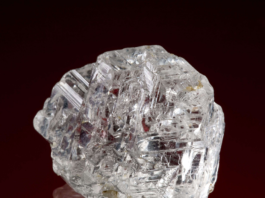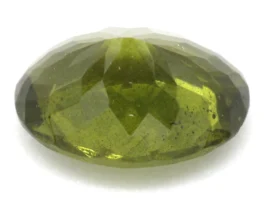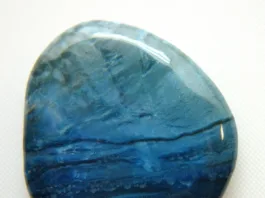Cavansite is a relatively rare and striking mineral known for its vibrant blue color. The name “cavansite” is derived from its chemical composition, as it contains calcium (Ca), vanadium (V), and silicon (Si). The mineral is typically found in crystal form, often in association with other minerals such as stilbite or heulandite.

One of the distinctive features of cavansite is its intense azure or deep blue hue, which can range from light blue to a more saturated, darker shade. This vivid coloration makes cavansite highly sought after by mineral collectors and enthusiasts.
Cavansite was first discovered in 1967 in Malheur County, Oregon, USA, but it has since been found in various locations around the world, including India, Brazil, and New Zealand. The most notable deposits are in the Deccan Traps region of India, where cavansite is often found in basaltic rocks within volcanic cavities.
In terms of its crystal structure, cavansite belongs to the zeolite group, which is a family of minerals characterized by a three-dimensional framework of tetrahedra. The crystals typically form in aggregates of small, prismatic or tabular crystals.
Beyond its aesthetic appeal, cavansite does not have significant industrial applications. However, its rarity, unique color, and crystal formations contribute to its popularity among mineral collectors and those with an interest in geological specimens. As with many minerals, cavansite’s value is influenced by factors such as color intensity, crystal size, and overall specimen quality.
Contents
Geological Formation of Cavansite

Cavansite is typically associated with volcanic or basaltic environments, and its formation is closely tied to specific geological conditions. The process by which cavansite forms involves a series of mineralogical and chemical interactions within cavities or vesicles in volcanic rocks. Here is an overview of the geological formation of cavansite:
- Volcanic Activity: Cavansite is often found in association with volcanic rocks, especially basalt. Basalt is a common volcanic rock that forms from the rapid cooling of lava. The volcanic activity provides the necessary conditions for the initial stages of cavansite formation.
- Vesicle Formation: During volcanic eruptions, gases, particularly water vapor and carbon dioxide, are released from the molten lava. As the lava cools and solidifies, these gases get trapped in cavities called vesicles, creating void spaces within the rock.
- Hydrothermal Activity: The trapped gases in the vesicles create an environment conducive to hydrothermal activity. Hot water rich in minerals percolates through the rock, carrying dissolved elements and contributing to the alteration of minerals present in the volcanic rocks.
- Introduction of Calcium, Vanadium, and Silicon: The mineral-forming process involves the introduction of calcium, vanadium, and silicon into the vesicles. These elements may come from various sources, including groundwater or fluids derived from the volcanic rocks themselves.
- Zeolite Formation: Cavansite belongs to the zeolite group of minerals, and its formation is part of a broader process involving the crystallization of zeolites. Zeolites are aluminosilicate minerals with a unique crystal structure. In the case of cavansite, the introduction of calcium, vanadium, and silicon in the vesicles triggers the growth of cavansite crystals.
- Cooling and Crystal Growth: As the hydrothermal fluids cool, the elements within them begin to crystallize, forming cavansite crystals. The crystals often appear as aggregates of small, prismatic or tabular crystals. The vibrant blue color of cavansite is thought to result from the presence of vanadium.
- Secondary Alterations: Over time, secondary alterations may occur, leading to the association of cavansite with other minerals like stilbite or heulandite.
It’s worth noting that the specific geological conditions, temperature, and composition of the volcanic rocks play a crucial role in determining the characteristics of cavansite specimens found in different locations around the world. The primary occurrences of cavansite are often in cavities or voids within volcanic rocks, where the mineral has had the opportunity to crystallize in its unique and recognizable form.
Physical Properties

Cavansite possesses several distinct physical properties that contribute to its identification and appreciation. Here are some key physical properties of cavansite:
- Color: The most striking feature of cavansite is its vibrant blue color. The hue can range from light blue to a more intense, saturated blue, making it one of the most appealing aspects of the mineral.
- Crystal System: Cavansite crystallizes in the orthorhombic crystal system. The crystals are typically prismatic or tabular in shape.
- Hardness: On the Mohs scale of mineral hardness, cavansite has a hardness of approximately 3. This means it is relatively soft compared to many common minerals and can be easily scratched.
- Luster: The mineral exhibits a vitreous (glass-like) luster when its surfaces are fresh and unaltered.
- Transparency: Cavansite crystals are often transparent to translucent, allowing light to pass through and contribute to their visual appeal.
- Cleavage: Cavansite may display good cleavage in one direction, which means it can break along specific planes. However, it is not always apparent in all specimens.
- Specific Gravity: The specific gravity of cavansite ranges from approximately 2.1 to 2.3. This value indicates how dense the mineral is compared to the density of water.
- Streak: The streak of cavansite, observed by rubbing the mineral on an unglazed porcelain plate, is typically white.
- Fluorescence: Some cavansite specimens exhibit fluorescence under ultraviolet (UV) light. The fluorescence can range from white to blue, adding an additional aspect to its visual allure.
- Associations: Cavansite is often found in association with other minerals, such as stilbite, heulandite, calcite, and apophyllite. These associations can influence the overall appearance and appeal of specimens.
These physical properties, especially the distinctive blue color, make cavansite a sought-after mineral for collectors and enthusiasts. The combination of its color, crystal structure, and associated minerals contribute to the uniqueness and beauty of cavansite specimens.
Colors and Varieties

Cavansite is primarily known for its vibrant blue color, which can range from light blue to a more intense, saturated blue. The striking blue hue is a result of the presence of vanadium in its chemical composition. While blue is the predominant color, there can be variations and combinations with other minerals that influence the overall appearance of cavansite specimens. Here are some color variations and associations with other minerals:
- Blue: The classic and most common color of cavansite is a vivid blue. The intensity of the blue can vary, and some specimens may exhibit a deeper, more saturated color than others.
- White: While the primary color of cavansite is blue, the mineral is often found in association with other minerals that can be colorless or white. For example, cavansite crystals may form alongside white stilbite or heulandite, creating a visually appealing contrast.
- Greenish tint: In some cases, cavansite may display a greenish tint, possibly due to the presence of impurities or variations in its chemical composition. However, blue is the dominant and characteristic color of cavansite.
It’s important to note that while cavansite primarily occurs in shades of blue, variations in color can occur based on factors such as mineral associations, impurities, or alterations. Collectors often appreciate the diversity of cavansite specimens, and the mineral’s color, combined with its crystal formations, contributes to its desirability among mineral enthusiasts.
Localities and Deposits

Cavansite has been found in various locations around the world, with some deposits being more significant than others. The mineral is often associated with volcanic or basaltic environments. Here are some notable localities where cavansite has been discovered:
- India: The most significant and well-known deposits of cavansite are in the Deccan Traps region of India. Pune, in the state of Maharashtra, is particularly famous for producing high-quality cavansite specimens. The mineral is often found in basaltic rocks within cavities or vesicles.
- United States: Cavansite was first discovered in the United States, specifically in Malheur County, Oregon. While not as abundant as in some other locations, Oregon has produced notable cavansite specimens.
- Brazil: Cavansite has been found in various locations in Brazil, including the states of Bahia and Rio Grande do Sul. Brazilian cavansite specimens are valued for their quality and color.
- New Zealand: The mineral has also been reported from locations in New Zealand, including on the North Island. Cavansite specimens from New Zealand are less common than those from other localities.
- Other locations: Cavansite has been reported in smaller quantities from other places, including China, Russia, and Mongolia. However, these occurrences are typically less significant in terms of the abundance and quality of cavansite specimens.
It’s worth noting that cavansite is often found in association with other minerals such as stilbite, heulandite, calcite, and apophyllite. The geological conditions in volcanic or basaltic settings, as well as the presence of specific minerals and elements, contribute to the formation of cavansite crystals. Mineral collectors and enthusiasts value cavansite specimens for their distinctive blue color, crystal formations, and associations with other minerals.
Uses of Cavansite

Cavansite, while visually striking and highly valued by mineral collectors, does not have significant practical uses beyond its aesthetic appeal. Its primary importance lies in its role as a beautiful and rare mineral specimen. Here are some aspects of cavansite’s uses:
- Mineral Collecting: Cavansite is highly sought after by mineral collectors and enthusiasts due to its vibrant blue color, distinctive crystal formations, and associations with other minerals. Collectors appreciate cavansite for its rarity and the aesthetic qualities it adds to mineral collections.
- Metaphysical and Spiritual Practices: Some individuals believe in the metaphysical and spiritual properties of minerals. Cavansite, with its calming blue color, is sometimes associated with properties such as promoting inner peace, enhancing intuition, and encouraging spiritual growth. These beliefs, however, are not scientifically supported.
- Jewelry and Ornamental Use: While cavansite is not commonly used in commercial jewelry due to its relative softness, some lapidaries and artisans may incorporate small cavansite crystals into custom-designed jewelry or ornamental pieces. However, this is more of an exception rather than a common practice.
It’s important to note that cavansite does not have industrial applications, and its use is primarily confined to the world of mineralogy, lapidary arts, and collector markets. The beauty of cavansite lies in its natural form, and its value is largely determined by factors such as color intensity, crystal size, and overall specimen quality.
Conclusion

In conclusion, cavansite is a captivating mineral known for its vibrant blue color, distinctive crystal formations, and associations with other minerals. Here is a summary of key points regarding cavansite and its significance in the mineral world:
- Definition: Cavansite is a relatively rare mineral composed of calcium, vanadium, and silicon. It belongs to the zeolite group and is characterized by its striking blue color.
- Geological Formation: Cavansite typically forms in volcanic or basaltic environments within cavities or vesicles. The mineralization process involves hydrothermal activity, the introduction of specific elements, and the crystallization of zeolites.
- Physical Properties: Cavansite exhibits a vibrant blue color, has a hardness of approximately 3 on the Mohs scale, and crystallizes in the orthorhombic system. It often appears in prismatic or tabular crystal formations and may display fluorescence under UV light.
- Colors and Varieties: The primary color of cavansite is blue, ranging from light to intense shades. It may also be associated with colorless or white minerals such as stilbite.
- Localities and Deposits: Significant deposits of cavansite have been found in India, particularly in the Deccan Traps region. Other notable occurrences include the United States, Brazil, New Zealand, and sporadically in other countries.
- Uses: Cavansite is primarily valued for its aesthetic appeal and is sought after by mineral collectors. It does not have practical industrial applications and is not commonly used in jewelry due to its softness.
Significance in the Mineral World:
Cavansite holds significance in the mineral world for several reasons:
- Aesthetic Appeal: The intense blue color and unique crystal formations make cavansite a prized specimen among mineral collectors, contributing to its desirability.
- Association with Zeolites: As a member of the zeolite group, cavansite contributes to the understanding of zeolite mineralogy and the geological processes that lead to their formation.
- Geological Indicators: The presence of cavansite in certain geological formations can serve as an indicator of specific volcanic or basaltic conditions, providing insights into the Earth’s history and processes.
Closing Remarks:
Cavansite, with its captivating beauty and geological significance, remains a notable and cherished mineral in the world of mineralogy. As collectors continue to appreciate its unique qualities, cavansite stands as a testament to the diversity and wonder of Earth’s mineral treasures.






